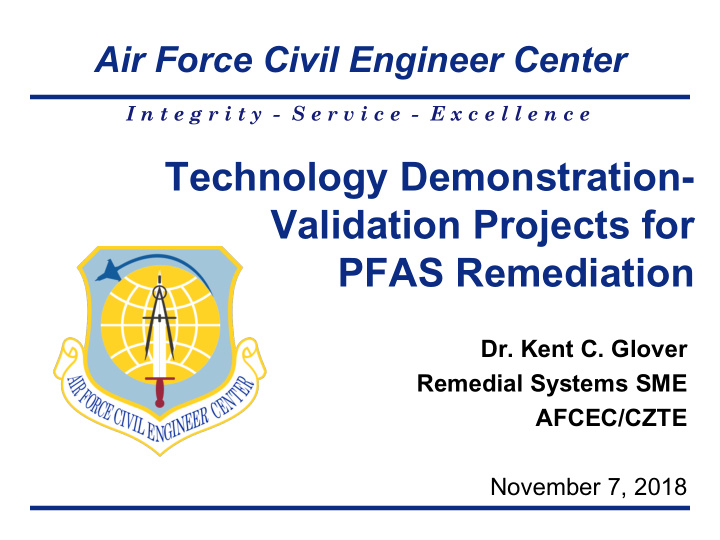



Air Force Civil Engineer Center I n t e g r i t y - S e r v i c e - E x c e l l e n c e Technology Demonstration- Validation Projects for PFAS Remediation Dr. Kent C. Glover Remedial Systems SME AFCEC/CZTE November 7, 2018
Purpose Survey of AFCEC demonstration-validation projects related to PFAS remediation technology • AFCEC role in technology development and technology transfer • Summary of completed and continuing projects • Examples • Source zone enhanced mass transfer and treatment • Electrochemical treatment • Enzymatic degradation PFAS: per- and polyfluoroalkyl substances 2
Environmental Broad Agency Announcement (BAA) • AFCEC environmental technology BAA projects Address AFCEC-specific technology challenges for priority sites • and contaminants Emphasize field-scale technology demonstration and validation • Promote technology transfer from pilot testing to wide-spread use • by remediation practitioners Address technology needs for environmental restoration and • compliance • Current BAA initiatives for environmental restoration High resolution site characterization • Remediation of persistent source zones • e.g., DNAPL, low permeability Characterization and remediation of emerging contaminants • e.g., PFAS, 1,4-D 3
Competed BAA Projects: PFAS Initiative Project Title End Date Chemical Treatment of Soil and Groundwater Contaminated with Perfluorinated 2013 Compounds found in Aqueous Fire Fighting Foams Chemical Oxidation and Inclusion Technology for Expedited Soil and 2015 Groundwater Remediation Use of Boron-Doped Diamond Electrodes for Treatment of Perfluorinated 2015 Compounds Is Bioremediation a Relevant 2014 Attenuation Mechanism for Perfluorinated Compounds? In-situ Enzymatic Oxidative Treatment for Perfluorinated Compounds 2017 Focused Remedial Investigation of Potential Ecological Effects of Perfluorinated 2015 Compounds and Associated Human Exposures from Fish Consumption • Available project information Fact sheet and presentations • Journal article(s) • Final report • 4
Enhanced Mass Transfer and Treatment of Source Zones • Concept Cyclodextrin (CD) to enhance contaminant availability • Advanced oxidation with liquid solution of dissolved ozone, • hydrogen peroxide, buffered sodium persulfate • Design High resolution site • characterization Project Area Bench-scale testing • Field pilot tests with three • treatment cells to optimize treatment sequence Langley-Eustis Fire Training Area BAA FA8903-11-C-8004: Chemical Oxidation and Inclusion Technology for Expedited Soil and Groundwater Remediation 5
Enhanced Mass Transfer and Treatment: Results • Optimal treatment: Sequential injections of MIP ECD Data oxidant, oxidant + CD, and oxidant • Different PFAS responded differently: some created, some transformed, some destroyed • Need to understand reaction chemistry Pre-Injection Post-Injection 6
Electrochemical Treatment of Perfluorinated Compounds • Concept PFAS degradation on surfaces of non-consumable electrical • anodes Mechanisms: direct electron transfer, hydroxyl radical generation, • oxidants generated from salts • Approach • Characterize PFAS at a FTA site • Lab tests with site groundwater mixed metal oxide (MMO) boron doped diamond (BDD) • Develop pilot-scale ex situ treatment unit BAA FA8903-11-C-8008 : Use of Boron-Doped Diamond Electrodes for Treatment of Perfluorinated Compounds 7
Electrochemical Treatment: Results Typical Lab Result • Laboratory results BDD anode generated perchlorate • (not recommended) MMO anode made of Ti/RuO 2 was • effective • PFOS: 98% mass recovery as fluoride • PFOA: 58% mass recovery as fluoride Pilot-Scale Treatment System • Pilot-scale demonstration was inconclusive Operational complications at treatment • facility Other contaminant interferences • More work needed for field-scale • Ti: Titanium implementation Ru: Ruthenium 8
Enzymatic Degradation • Concept Highly reactive oxidizing agents for non-selective • degradation (e.g. laccase) Couple with GAC to destroy PFAS and • delay breakthrough • Approach Laboratory testing • Enzyme selection based on reactivity, stability/activity and cost Pilot-scale demonstration • Characterize GAC breakthrough (PFAS, precursors); Introduce enzyme to GAC column; Rest column (1 month); resume flow BAA FA8903-12-C-0005: In-situ Enzymatic Oxidative Treatment for Perfluorinated Compounds 9
Enzymatic Degradation: Results • Lab study shows reaction is very slow Water: 40% PFOA and 60% PFOS • Soil slurry: 40% PFOA • Shows potential if coupled with separation • technology to delay PFAS breakthrough • Pilot test Comparison of GAC breakthrough vs. • GAC + enzyme-catalyzed degradation not promising Benefit significant only for PFBA • Options for optimization: Add O 2 , extend • reaction time, mediator amendment HBT: hydroxybenzotriazole PFBA: perfluorobutyrate 10
Current BAA Projects: PFAS Initiative Project Title Media Status Perfluorochemical Treatment by Water Lab phase complete. Pilot-scale Nanofiltration Plus Sequential UV (ex situ) system being constructed. Field- Oxidative/Reductive Treatment of Reject scale testing planned for FY2019. Water Enhanced Contact Electrical Discharge Water Bench scale reactor successful. Plasma Reactor (ex situ) Pilot-scale skid being constructed. Field-scale testing ~ Feb 2019. Field-Scale Comparison of Adsorbents for Soil Field demonstration complete. In Situ Stabilization of Poly- & Post-treatment soil cores Perfluorinated Alkyl Substances (PFAS) collected for lab analysis. Coupling Ion-Exchange Resin with Water Lab testing phase complete. Pilot- Electrochemical Treatment For Complete (ex situ) scale system for treating resin still Separation and Destruction of PFOS and bottoms being developed. PFOA in Groundwater 11
PFAS Ex Situ Treatment Concepts in BAA Projects Nanofiltration + sequential UV oxidation/reduction Plasma reactor Uses electricity to convert water to reactive chemical species, UV radiation and shockwaves for cavitation and thermal treatment Ion exchange + electrochemical treatment On-site resin regeneration PFAS degradation with ceramic titanium oxide electrode Bench Scale Plasma Reactor 12
Discussion and Questions Air Force Civil Engineer Center (AFCEC) Environmental Management Directorate Technical Division (CZTE) Kent Glover, Remedial Systems SME: kent.glover@us.af.mil Monique Nixon, BAA Program Manager: monique.nixon@us.af.mil AFCEC BAA email: afcec.czte.baa@us.af.mil AFCEC web: https://www.afcec.af.mil/ 13
Recommend
More recommend